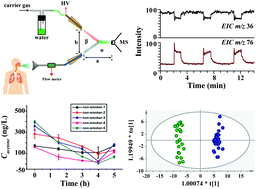Rapid and sensitive detection of acetone in exhaled breath through the ambient reaction with water radical cations†
Abstract
The levels of acetone and other ketones in exhaled human breath can be associated with various metabolic conditions, e.g. ketosis, lung cancer, dietary fat loss and diabetes. In this study, ketones in breath samples were charged through the reaction with water radical cations to form [M + H2O]˙+ ions, which were detected by mass spectrometry. Our experimental data indicate that under the optimized experimental conditions, the limit of detection for acetone using our approach is 0.14 ng L−1 (∼0.06 ppb). The linear dynamic range of detection spans four orders of magnitude. The developed approach was applied to real-time semi-quantitative analysis of acetone in the exhaled breath of human volunteers, revealing significantly higher levels of acetone in the breath of smokers compared to non-smokers. The developed approach features the obviation of sample collection, easy operation, high speed of analysis (10 s per run), high sensitivity, and spectral interpretation, which indicates the potential of ambient corona discharge ionization mass spectrometry as a selective, sensitive and noninvasive technique for the determination of exhaled ketones in clinical diagnosis including lung cancer, diabetes, etc.



 Please wait while we load your content...
Please wait while we load your content...